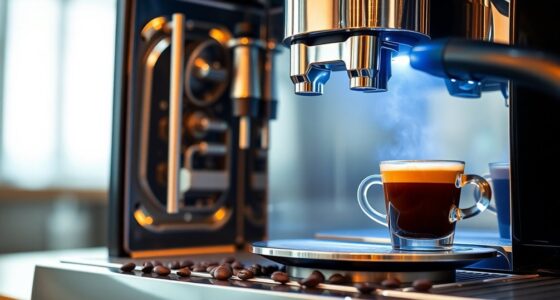Some espresso machines use PID controllers to maintain precise brewing temperatures, helping you achieve consistent flavor extraction. Unlike traditional methods that can fluctuate by several degrees, PID systems keep temperatures stable within ±0.5°C. This precision enhances your coffee’s flavor profile and improves shot consistency, especially when working with different bean types. If you’re curious about how to install a PID or what benefits it offers for your brewing setup, there’s more to explore.
Key Takeaways
- PID controllers maintain temperature stability within ±0.5°C, crucial for consistent espresso extraction and flavor profiles.
- They allow customization of brewing conditions based on different coffee beans, enhancing overall quality.
- Faster recovery times between shots improve efficiency, especially in busy commercial settings.
- User-friendly interfaces make PID systems accessible, eliminating the need for advanced programming skills.
- The investment in PID technology yields long-term benefits, including reduced maintenance costs and improved espresso flavor extraction.
Understanding PID Controllers

When it comes to brewing the perfect cup of espresso, understanding PID controllers is essential. PID, which stands for Proportional-Integral-Derivative, serves as a digital temperature controller in espresso machines.
It directly measures and regulates the water temperature in the boiler, maintaining fluctuations within ±0.2°C. This precision enhances temperature control, ensuring consistent espresso extraction.
Unlike traditional pressurestats, PID controllers allow you to fine-tune brewing temperatures to match different coffee beans, revealing a broader range of flavors.
Additionally, PID technology reduces the deadband of temperature fluctuations, creating a more stable brewing environment.
With solid-state relays that outlast mechanical ones, PID controllers contribute to safer and more durable espresso machines, elevating your overall coffee experience. Furthermore, the implementation of automation technologies in espresso brewing can lead to improved efficiency and consistency in coffee preparation.
The Importance of Temperature in Brewing
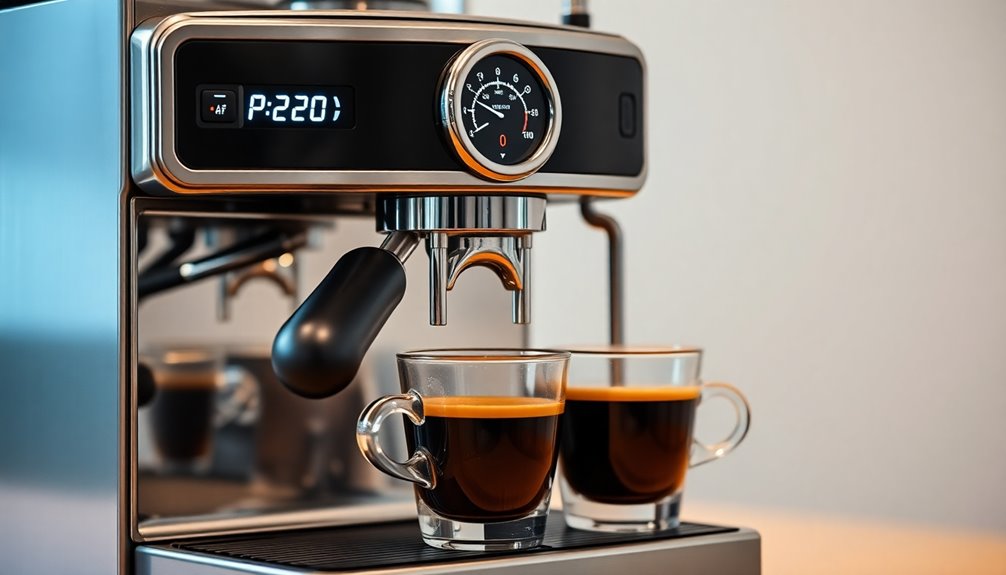
Temperature stability plays a significant role in brewing the perfect espresso. Fluctuations of just 1–2°C can drastically change the flavor, making precise control crucial. This is where PID controllers help, maintaining a brewing temperature within a tight ±0.5°C range. In contrast, non-PID machines can swing ±3°C to ±5°C, leading to inconsistent taste.
| Brewing Temperature (°C) | Flavor Profile |
|---|---|
| 90 | Bright, fruity notes |
| 92 | Balanced, well-rounded |
| 94 | Rich, chocolate tones |
| 96 | Bold, intense flavors |
| 98 | Over-extracted bitterness |
With PID systems, you enjoy enhanced extraction consistency, allowing for the ideal flavor from every bean you brew. This precision is fundamental for serious coffee enthusiasts. Additionally, maintaining clean air quality in the brewing environment can further enhance the overall coffee experience by reducing unwanted odors that may affect the taste.
Benefits of PID Controllers in Espresso Machines
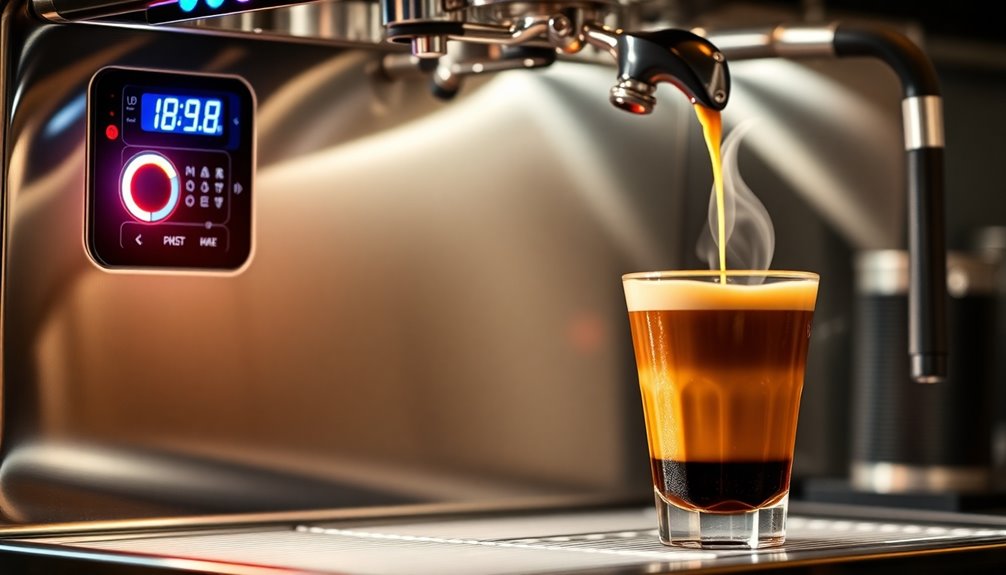
While many espresso machines struggle with temperature fluctuations, PID controllers offer a solution that elevates your brewing experience. They maintain PID temperature within a narrow range of ±0.5°C, ensuring superior temperature stability compared to non-PID machines that can vary by ±3°C or more.
This precise control allows you to customize your brewing conditions based on the type of coffee beans, optimizing flavor profiles for both light and dark roasts. Additionally, PID systems feature user-friendly interfaces that make digital adjustments easy, reducing the chances of manual errors.
With faster recovery times between shots, these machines excel in busy cafés, meeting high demand without compromising quality. Though they may cost more, the consistency and quality they provide are well worth the investment. Moreover, many of the best espresso machines under $1000 incorporate PID technology, making it accessible for home users seeking high performance without breaking the bank.
PID vs. Traditional Temperature Control Methods
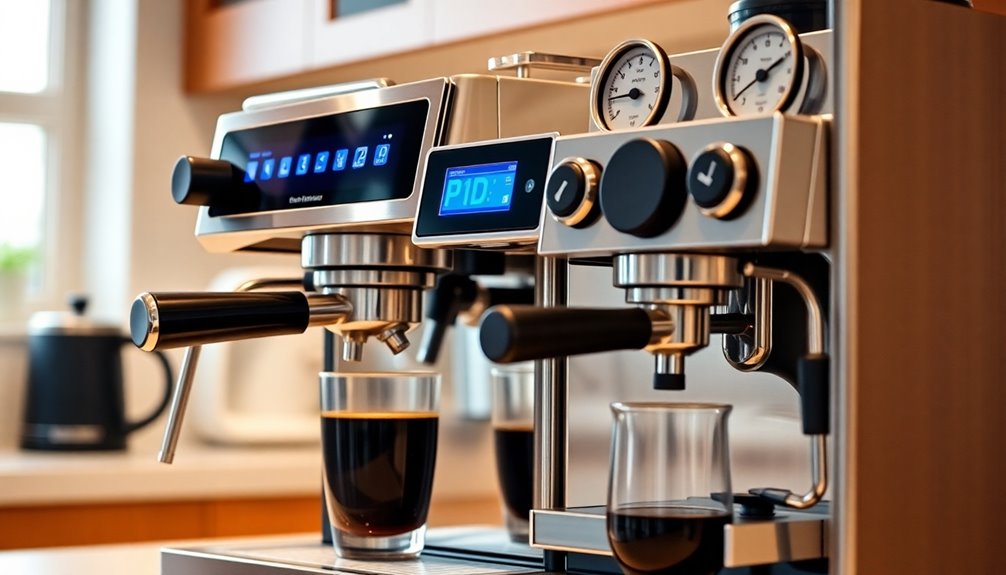
When you compare PID controllers to traditional temperature control methods, the differences in precision and stability become clear.
While older systems might let temperatures fluctuate considerably, PID controllers keep things tight, allowing you to customize your brew to your exact preferences.
This level of control not only enhances your coffee experience but also guarantees consistent results every time you pull a shot. Furthermore, just like how heat pump systems maintain optimal temperature regulation, PID controllers ensure that your brewing temperature remains steady.
Precision in Temperature Control
Achieving consistent espresso quality hinges on precise temperature control, and PID controllers excel where traditional methods fall short.
With PID control, you can maintain temperature stability within ±0.2°C, considerably reducing fluctuations compared to conventional pressurestats, which may swing by ±2°C or more.
Unlike traditional systems that rely on pressure readings, PID controllers directly measure water temperature, allowing for faster and more accurate adjustments.
This narrow deadband of temperature fluctuation guarantees consistent brewing temperatures, enhancing flavor extraction and overall espresso quality.
Furthermore, PID technology lets you experiment with varying temperatures, tailoring your brewing coffee to different bean types and personal preferences.
This level of precision simply isn’t possible with standard methods, making PID controllers a game-changer for espresso enthusiasts. Additionally, maintaining a budget for coffee equipment can help you make informed investments in quality espresso machines.
Stability Over Time
To guarantee consistent espresso quality, understanding the differences in stability between PID controllers and traditional temperature control methods is crucial.
PID systems maintain brewing temperature within a tight ±0.5°C range, drastically improving stability compared to traditional pressurestats, which can fluctuate by ±2°C or more.
Non-PID machines often experience temperature swings of ±3°C to ±5°C, leading to unpredictable flavor profiles.
The precision of PID technology allows for rapid adjustments based on real-time temperature readings, ensuring stable conditions throughout the brewing process.
This minimizes temperature variations and enhances flavor extraction, resulting in a more consistent espresso.
For both serious enthusiasts and professional baristas, the stability provided by PID controllers is essential for achieving high-quality espresso consistently. Additionally, HEPA filtration is crucial for capturing small particles effectively in air purifiers, paralleling the precision needed in espresso brewing for optimal results.
User Customization Options
While traditional temperature control methods often leave you with limited options for customization, PID controllers empower you to fine-tune your brewing experience.
With PID espresso machines, you can make precise temperature adjustments within a ±0.5°C range, catering to various coffee bean types and roast levels. Digital interfaces let you easily set and modify brew temperatures based on your preferences, encouraging experimentation with flavors and extraction profiles.
Unlike traditional pressurestats that fluctuate ±2°C or more, PID systems adapt automatically to environmental changes, ensuring stable temperatures. You can even save and recall specific settings for different coffee profiles, enhancing user customization options.
Plus, PID controllers reduce temperature recovery time, allowing you to maintain ideal brewing conditions during high-demand moments. Furthermore, similar to the advanced filtration systems found in top-rated vacuums, PID technology enhances precision and consistency in the brewing process.
Installing a PID Controller in Your Espresso Machine
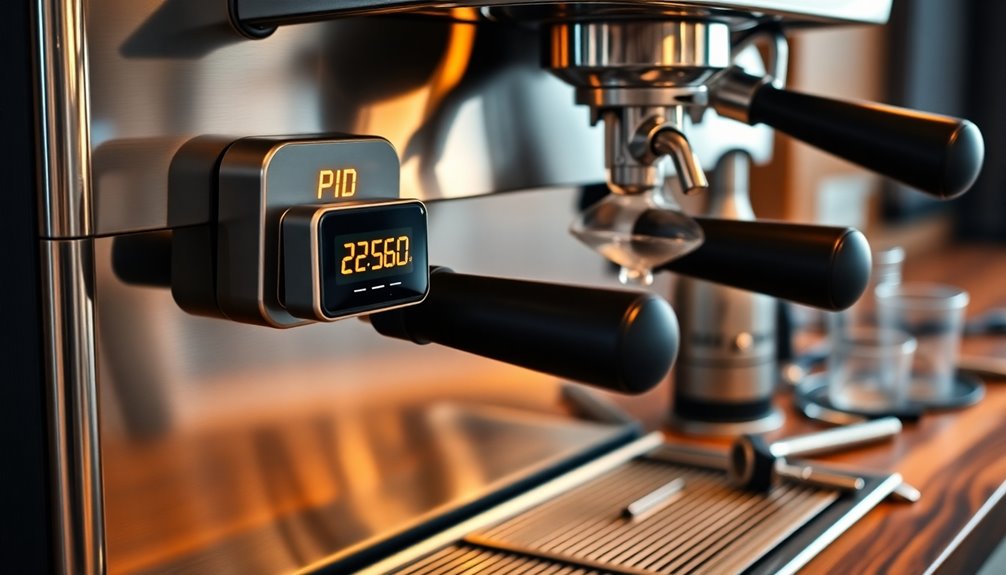
Installing a PID controller in your espresso machine can seem intimidating, especially if you’re not familiar with electrical work and programming. However, after-market PID kits are available for various espresso machine models, making the process easier.
You’ll need to disconnect the existing thermostat and rewire the internal components, which can differ in complexity depending on your machine. Be aware that this modification might void your manufacturer’s warranty, so consider this carefully.
Once installed, a PID controller offers enhanced temperature stability, allowing for precise PID control over brewing temperatures. This precision can lead to greatly improved espresso quality, making the effort worthwhile for enthusiasts looking to elevate their coffee experience. Additionally, just as in home cinema projectors, consistent temperature control enhances overall performance and quality in espresso brewing.
Assessing Your Need for a PID Controller
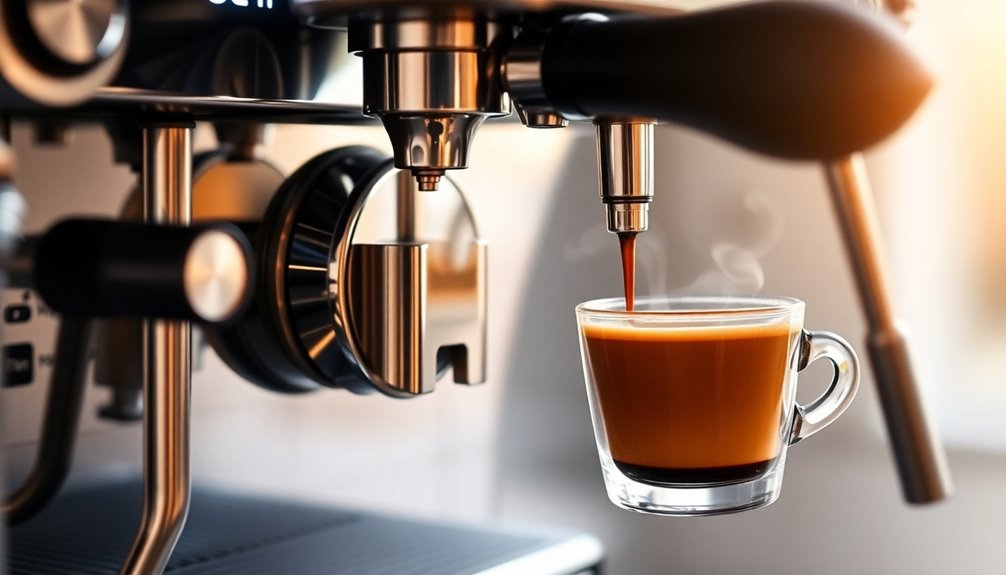
How can you determine if a PID controller is right for your espresso brewing needs?
If you’re a serious coffee enthusiast, investing in a PID-equipped espresso machine can enhance your temperature control. With a PID, you can maintain brewing temperatures within a ±0.5°C range, allowing you to explore different flavors more effectively.
Investing in a PID-equipped espresso machine enhances temperature control, enabling precise brewing for flavor exploration.
If you brew frequently and seek consistent shot quality, a PID system may be ideal for you. On the other hand, casual drinkers mightn’t notice the benefits as much.
Additionally, PID controllers improve efficiency in commercial settings by minimizing recovery times between shots. Investing in a PID machine can be compared to the advantages of a Gold IRA, as both provide a strategic approach to optimizing your desired outcomes.
If you’re committed to elevating your coffee experience, the investment of $200 to $500 for a PID machine can be worthwhile.
Common Misconceptions About PID Systems
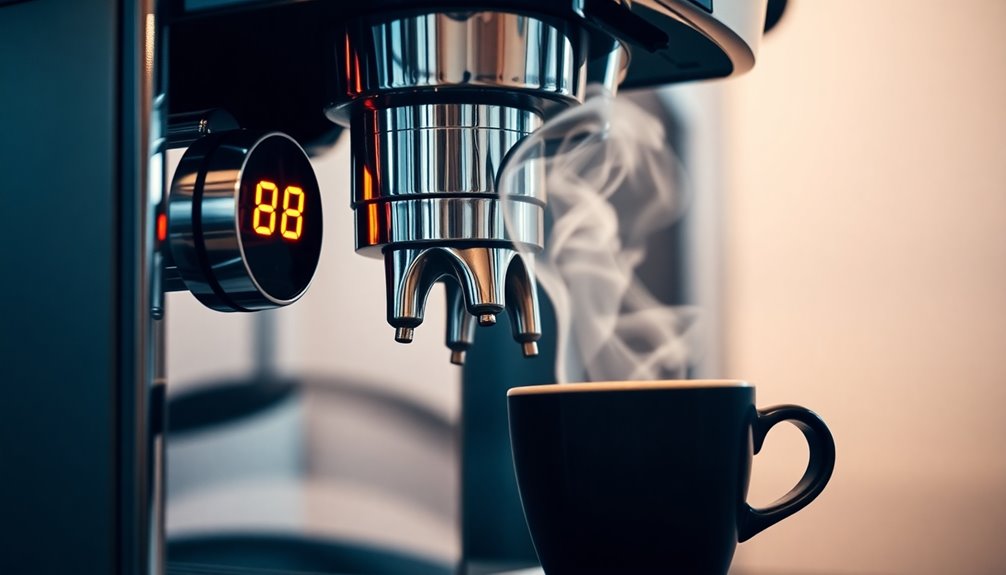
You might think PID systems are too complex for everyday use, but many machines make temperature adjustments easy.
There’s also a misconception that the cost isn’t worth it, yet the benefits in espresso quality often justify the investment.
Plus, installation isn’t as intimidating as it seems; understanding these systems can elevate your brewing experience. Additionally, the concept of emotional well-being is enhanced through precise temperature control, allowing for a more enjoyable coffee-making ritual.
PID Complexity Misunderstood
Why is there so much confusion surrounding PID controllers in espresso machines? Many misconceptions cloud their true benefits. Here are some common misunderstandings:
- Overly Complex: PID control isn’t just for techies; it enhances temperature stability for everyone.
- Only for Advanced Users: Even casual drinkers can benefit from precise temperature adjustments.
- Exclusively Commercial: PID controllers are increasingly found in home espresso machines, making quality accessible.
- Technical Knowledge Required: Most modern PID systems feature user-friendly interfaces, eliminating the need for deep programming skills.
These points show that PID controllers aren’t just complicated gadgets—they’re essential tools for achieving consistent and delightful espresso results.
Don’t let misconceptions hold you back from exploring their advantages!
Cost vs. Benefits
Misunderstandings about PID controllers often lead to confusion regarding their cost versus benefits. While spending an extra $200–$500 for a PID-equipped espresso machine might seem steep, serious coffee enthusiasts recognize the value it brings.
The precise temperature control offered by PID systems greatly enhances flavor extraction, making your espresso taste better. Many casual drinkers underestimate this benefit, believing PID technology is unnecessary.
However, the long-term advantages, like reduced wear on internal components and quicker recovery times, can lower maintenance costs over time. For baristas in busy environments, investing in PID technology boosts efficiency and consistency, making it a smart cost for anyone looking to elevate their espresso-making game.
Ultimately, the benefits often outweigh the initial expense.
Installation Challenges Faced
Although many espresso enthusiasts are keen to enhance their brewing experience with a PID controller, the installation process can be more complicated than it seems. Here are some common installation challenges you might face:
- Rewiring Requirements: You’ll often need to rewire existing components, which can intimidate those without electrical experience.
- Programming and Calibration: Many think it’s a plug-and-play process, but careful programming is essential for proper functioning.
- Warranty Concerns: Installing an after-market PID kit may void your espresso machine’s warranty.
- Modifiability Limits: Not all machines are easily modifiable for PID integration, and some models may complicate the installation.
Additionally, don’t underestimate the impact of water quality; limescale can affect both the PID sensor and machine performance post-installation.
The Future of PID Technology in Espresso Machines

As the coffee industry evolves, the future of PID technology in espresso machines looks promising, with advancements set to redefine brewing precision.
With the potential for temperature control accuracy within ±0.1°C, you’ll experience enhanced flavor extraction like never before.
As smart technology becomes common, expect PID (Proportional-Integral-Derivative) Controllers to offer connectivity for remote monitoring through mobile apps, allowing you to personalize your brewing experience.
Ongoing innovations in PID algorithms will improve responsiveness to temperature fluctuations, ensuring ideal conditions regardless of your environment.
Plus, the trend towards sustainability may lead to energy-efficient PID-equipped machines that maintain precise temperature control while reducing power consumption.
This evolution could make high-quality brewing more accessible, aligning with the rise of specialty coffee culture.
Frequently Asked Questions
What Does a PID Controller Do on an Espresso Machine?
A PID controller in your espresso machine maintains the brewing temperature with impressive precision.
It continuously monitors and adjusts the water temperature, ensuring it stays within a narrow range, which helps you achieve consistent espresso extraction.
You’ll notice that it minimizes temperature fluctuations that can affect flavor.
With a PID controller, you can also customize brewing temperatures for different coffee beans, enhancing the unique flavors of each roast you use.
Do I Really Need a PID for Espresso?
Imagine pulling that perfect shot, the rich aroma swirling around you, and you wonder if you really need a PID for espresso.
If you’re serious about your coffee, a PID controller can make a world of difference. It keeps your brewing temperature steady, ensuring every cup is consistently delicious.
While it might be an added expense, the precision it offers can elevate your espresso experience beyond the ordinary, making it worth the investment.
What Are the Advantages of PID Controller?
When you consider the advantages of a PID controller, you’ll find it offers remarkable temperature stability, keeping fluctuations minimal.
This precision means you can tailor brewing temperatures to match different coffee beans, optimizing flavor extraction.
Plus, the user-friendly interface allows you to make digital adjustments easily, whether you’re a beginner or an expert.
With quicker recovery times between shots, you’ll enjoy consistent results, especially during busy brewing sessions.
It’s a worthwhile investment for serious coffee enthusiasts!
What Is the PID Pressure on an Espresso Machine?
The PID pressure in an espresso machine is like having a maestro conducting a symphony of flavors!
It refers to the precise pressure readings that keep your brewing temperature stable. With a PID controller, you’re minimizing pressure fluctuations, which means your espresso extraction is more consistent.
It allows you to fine-tune the pressure for different coffee types, ensuring you get the perfect shot every time. Enjoy that rich, flavorful cup you’ve always dreamed of!
Conclusion
Incorporating a PID controller into your espresso machine might seem like an unnecessary upgrade, but once you experience the precise temperature control, you’ll see the difference in your brews. With consistent temperatures, you can release the full potential of your coffee beans, enhancing flavors you never knew existed. Investing in a PID isn’t just about technology; it’s about elevating your coffee experience. Embrace the future of brewing, and take your espresso to the next level!





